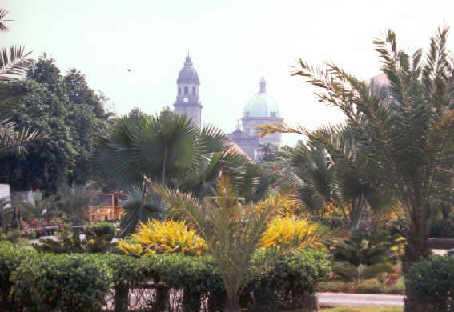Fabulous Philippines > Manila
Manila
Share this page:
Located on Manila Bay, one of the finest harbors in the world, Manila, the capital of the Philippines, is a mega-city of more than 12 million people.
Metro Manila is a vast sprawling conurbation, over 600 square kilometers in size, which never sleeps. It ranges from the super-rich suburbs such as Forbes Park to desparately poor neighborhoods such as Tondo.
It ranges from elegant boulevards (such as Roxas Blvd. on Manila Bay) to an immense old Spanish fortress city (Intramuros) to shopping streets (such as Escolta St and Rizal Avenue) and market areas (such as Divisoria), from a lively Chinatown (Binondo; Ongpin Street) to the home of the President (Malancanang Palace in San Miguel), from business skyscrapers (in Makati) to wonderful old churches (such as Quiapo Church) and areas of lively nightlife.

Intramuros, the old city of Manila, dating from Spanish colonial times
There are numerous daytrips from Manila of great interest to the visitor: Corregidor Island, where you can see the relics of titan struggles during World War II; the Pagsanjan waterfalls and rapids; and the Taal volcano and lake.
Some of Manila's tourist attractions:
-- Rizal Park (Luneta)
-- Rizal Monument
-- Intramuros
-- Fort Santiago
-- San Augustin Church
-- Manila Cathedral
-- Casa Manila
-- Quiapo Church
-- Chinatown
-- Binondo Church
-- Chinese Cemetery
-- Malacanang Palace
-- Malate Church
-- Cultural Center of the Philippines
-- Coconut Palace
-- American Military Cemetery and Memorial
-- Nayong Filipino
-- Manila Zoo
-- Paco Park and Cemetery
A Little History
Manila (whose name comes from the Tagalog words referring to waterlilies) had been a commercial center for many centuries when the Spanish arrived in the 16th century.
In 1571 the Spanish navigator, Miguel Lopez de Legazpi, proclaimed Manila as capital of the Philippines (the capital had previously been Cebu in the central Philippines) and built a fortress there. King Philip II of Spain conferred the title of Isigne y Siempre Leal Ciudad (Spanish, "Distinguished and Ever Loyal City") on the city.
The center of the Spanish city of Manila was a huge fortress named Intramuros (Spanish, "between the walls") which was home for the Spanish administrators, friars and merchants. From here they would spread their control across the Philippine archipelago.
The galleon trade began which consisted of galleons arriving and departing with rich cargoes of goods going to and from the motherland, Spain, via Mexico. Under this system, Manila prospered while most of the provinces remained backward.
Over the centuries there were uprisings by the immigrant Chinese and by the native Filipinos, military struggles with other European powers (Dutch blockades; a brief British occupation in 1762-64) and four major earthquakes (for example, in 1863).
Manila was a closed city until 1834 when for the first time foreign shipping was allowed to enter the Philippines. It had also been a closed city to new ideas but this gradually changed in the 19th century too. In 1896 the great Filipino writer and leader, José Rizal, was executed in Manila by the Spanish and shortly thereafter an armed rebellion broke out against Spanish rule in the Philippines.
In 1898 the Spanish-American War began with the result that the Philippines fell into the hands of a new colonial power, the United States.
The Second World War had a disastrous effect on Manila. The Japanese combat with the Americans in 1945 left the whole city (including Intramuros) in ruins. Manila was called the "Warsaw of Asia" (Warsaw, Poland, having been similarly flattened by the war). Hundreds of thousands of Filipinos died.
With post-war independence came reconstruction of Manila, but this was done in a quite patchy manner. Over the past decades Manila has experienced a huge population growth with a never-ending arrival of people from the provinces coming to try and find work in the big city.
Share this page:
Author: David Paul Wagner
(David Paul Wagner on Google+)
|